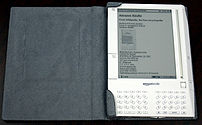
- Image via CrunchBase
PC Magazine has a great article this week about the success of the Kindle, entitled Amazon’s Kindle Secret is in the Software. In it, Dan Costa argues that the announcement of a free Kindle Reader for the iPhone cements Amazon’s leadership role in the e-book market.
If you didn’t hear, Amazon released a Kindle reader for the iPhone and iPod Touch. Not only will it allow you access to the content you’ve purchased on the Kindle(if you have such content), but it will take you to where you left off, and allow you to view, but not edit, annotations and bookmarks you made on the Kindle. Thus, it seems to be for people who have already bought a Kindle, and wish to use their iPhone as a secondary reading device. And you need a computer to buy the books, it is apparently not easy to do from the iPhone itself(Disclosure: None here owns an iPhone)
What Amazon offers through Kindle is a DRM system for e-books. While the DRM is up to the content providers, most publishers have opted to lock up their books. Now, they are allowing content providers to enable or disable the text-to-speech options for their books. It is this closed format that allows Amazon to have collected over 230,000 titles in Kindle format. The Kindle doesn’t support ePub, the open digital book standard sponsored by the International Digital Publishing Forum (IDPF).
As Costa puts it:
Open-minded publishers like Tim O’Reilly, founder and CEO of O’Reilly Media, have already balked at joining Amazon’s single-source, single-file-format delivery system. As the market grows, so will the demand for alternatives. Even Apple supports multiple file formats on the iPod.
We object to any locked device. We understand DRM, but any good device should support alternative choices. As O’Reilly Radar points out, Amazon wants to own not only the hardware market, and the e-book format market. By releasing applications for other devices, they can do that. Techfragments predicts that a desktop and/or web-based version is probably in the works. The sync that allows you to pick up where you left off on the iPhone from your Kindle could work well on the desktop. And with hardcover book sized netbooks becoming popular, this will be another platform they can offer.
Amazon pushing the books over the devices will allow them greater long-term profit and control of the market. They can continue to offer free applications, offer a hardware device, and reap the benefits on all fronts.
Related articles by Zemanta
- Kindle Above the Level of a Single Device (radar.oreilly.com)
- Amazon Kindle For iPhone (oliverwillis.com)
- Kindle is not the best iPhone e-reader (news.cnet.com)
- When Gadgets Collide: Kindle for Your iPhone (blippitt.com)
- Amazon Releases Kindle for iPhone App (mediabistro.com)
- Amazon to Sell E-Books for Apple Devices (nytimes.com)
- Turn Your iPhone Into a Kindle (abcnews.go.com)
- All the Features You Expect, But No Built-In Store (tsurch.com)

![Reblog this post [with Zemanta]](http://img.zemanta.com/reblog_e.png?x-id=f0dbd97a-0480-4e07-94fd-368fde8cc416)


![Reblog this post [with Zemanta]](http://img.zemanta.com/reblog_e.png?x-id=747260c7-bcb6-40bb-8d0b-b11676719cb7)


![Reblog this post [with Zemanta]](http://img.zemanta.com/reblog_e.png?x-id=7ed13cf3-d5d3-49a2-93ab-b6b2af2f787e)


![Reblog this post [with Zemanta]](http://img.zemanta.com/reblog_e.png?x-id=1a20142d-d75a-4944-a14c-864798a5c6d4)